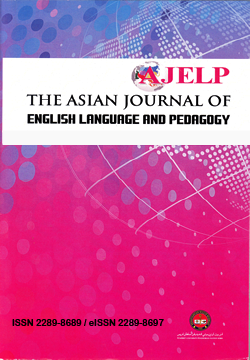Blended Learning Implementation for Language Learning in Remote Area after Covid-19 Outbreak: A Convergent Parallel Mixed-method Research Design
DOI:
https://doi.org/10.37134/ajelp.vol11.2.10.2023Keywords:
Blended learning, EFL Teachers’ Motivation, Implementation, Language Instruction, Technology IntegrationAbstract
Technology integration is now widely used in higher education contexts. It can foster teachers’ and students' motivation and engagement in the educational process. Blended learning combines conventional methods with technology-assisted learning, open online resources, and free emerging devices. This study aims to investigate EFL teachers’ motivation in implementing the Blended learning technique for language instruction. The research utilized a mixed-method approach (convergent parallel design) by designing the instruments of closed-ended questionnaires and semi-structured teachers’ interviews (QUAN and QUAL). This study was conducted at several educational institutions and 30 respondents were purposively assigned. The finding of this research indicated that the implementation is related to EFL teachers’ professional training, expertise, and needs. Besides, this technique can leverage teacher aptitudes in digital literacy that lead to a better learning environment and foster academic performance of the students. Pedagogical implications of the implementation of the blended learning approach are discussed and it provides insight to educators and practitioners a better understanding of technology integration in EFL settings, especially blended learning.
Downloads
References
Abusalim, N. (2020). Institutional adoption of blended learning on a budget. 34(7), 1203–1220. https://doi.org/10.1108/IJEM-08-2019-0326
Arifani, Y., Mindari, R., Hidayat, N., & Wicaksono, A. S. (2021). Basic psychological needs of in-service EFL teachers in blended professional training: voices of teachers and learners. Interactive Learning Environments, 0(0), 1–14. https://doi.org/10.1080/10494820.2021.1943691
Berge, Z. (1995). The role of the online instructor/facilitator. 35.1 (1995): 22-30. Educational Technology, 35(1), 22–30. http://www.cordonline.net/mntutorial2/module_2/Reading 2-1 instructor role.pdf
Berman, E. A. (2017). An Exploratory Sequential Mixed Methods Approach to Understanding Researchers ’ Data Management Practices at UVM : Integrated Findings to Develop Research Data Services Full-Length Paper. 6(1). https://doi.org/10.7191/jeslib.2017.1104
Boelens, R., Voet, M., & De Wever, B. (2018). The design of blended learning in response to student diversity in higher education: Instructors’ views and use of differentiated instruction in blended learning. Computers and Education, 120(February), 197–212. https://doi.org/10.1016/j.compedu.2018.02.009
Chien, C. W. (2022). Analysis of blended learning training sessions for Taiwanese elementary school English teachers. Education 3-13, 50(1), 111–128. https://doi.org/10.1080/03004279.2020.1833064
Echevarría, J., Vogt, M., & Short, D. J. (2012). Making Content Comprehensible for English Language Learners: The SIOP Model (Book). Modern Language Journal, 17(3), 277–278.
Erarslan, A., & Asmalı, M. (2022). EFL Teachers ’ Work Tasks Motivation towards Class Preparation , Teaching , and Evaluation of Students. 12(1), 1–22. https://doi.org/10.2478/atd-2022-0001
Fung, C. Y., & Adams, E. A. (2017). on College Campuses ? An In-Depth Qualitative Study. Balsano 2005. https://doi.org/10.3390/socsci6040134
Garrison, R., Anderson, T., & Archer, W. (2000). Critical Inquiry in a text-based environment. The Internet and Higher Education, 2(2), 87–105.
Grønmo, S. (2019). Social Research Methods: Qualitative, Quantitative and Mixed Methods Approaches. SAGE Publications. https://books.google.com.my/books/about/Social_Research_Methods.html?id=8vW4wgEACAAJ&redir_esc=y
Guan, A., Cruz, T., Mattias, B., Shah, A., Hassberg, A. H., & Shariff-marco, S. (2023). Combining Mixed Methods and Participatory Research Approaches to Identify Neighborhood-Level Needs During the COVID-19 Pandemic. 0(0), 1–15. https://doi.org/10.1177/15586898231222037
Guillén-Gámez, F. D., Lugones, A., Mayorga-Fernández, M. J., & Wang, S. (2019). ICT use by pre-service foreign languages teachers according to gender, age and motivation. Cogent Education, 6(1). https://doi.org/10.1080/2331186X.2019.1574693
Hamzah, M. I. M., Juraime, F., & Mansor, A. N. (2016). Malaysian Principals’ Technology Leadership Practices and Curriculum Management. Creative Education, 07(07), 922–930. https://doi.org/10.4236/ce.2016.77096
Huang, Q., & Lee, V. W. Y. (2022). Exploring first-year university students’ blended learning experiences during the COVID-19 through the community of inquiry model. International Journal of Information and Learning Technology, 39(4), 373–385. https://doi.org/10.1108/IJILT-02-2022-0024
Jiang, L. (2022). Factors influencing EFL teachers’ implementation of SPOC-based blended learning in higher vocational colleges in China: A study based on grounded theory. Interactive Learning Environments, 1–20. https://doi.org/10.1080/10494820.2022.2100428
Maria Josephine Arokia Marie, S. (2021). Improved pedagogical practices strengthens the performance of student teachers by a blended learning approach. Social Sciences & Humanities Open, 4(1), 100199. https://doi.org/10.1016/j.ssaho.2021.100199
Milic, S., & Simeunovic, V. (2022). Teachers’ roles in online learning communities: a case study from the digitally underdeveloped country. Interactive Learning Environments, May, 1–12. https://doi.org/10.1080/10494820.2022.2081210
Minhas, W., White, T., Daleure, G., Solovieva, N., & Hanfy, H. (2021). Establishing an Effective Blended Learning Model: Teacher Perceptions from the United Arab Emirates. SAGE Open, 11(4). https://doi.org/10.1177/21582440211061538
Rasheed, R. A., Kamsin, A., & Abdullah, N. A. (2020). Challenges in the online component of blended learning: A systematic review. Computers and Education, 144(March 2019), 103701. https://doi.org/10.1016/j.compedu.2019.103701
Simonova, I. (2019). Blended approach to learning and practising English grammar with technical and foreign language university students: comparative study. Journal of Computing in Higher Education, 31(2), 249–272. https://doi.org/10.1007/s12528-019-09219-w
Subedi, D. (2016). Explanatory Sequential Mixed Method Design as the Third Research Community of Knowledge Claim. 4(7), 570–577. https://doi.org/10.12691/education-4-7-10
Ulla, M. B., & Perales, W. F. (2021). Facebook as an integrated online learning support application during the COVID19 pandemic: Thai university students’ experiences and perspectives. Heliyon, 7(11), e08317. https://doi.org/10.1016/j.heliyon.2021.e08317
UNESCO. (2020). Education: From COVID-19 school closures to recovery. https://www.unesco.org/en/covid-19/education-response
Wang, N., Chen, J., Tai, M., & Zhang, J. (2021). Blended learning for Chinese university EFL learners: learning environment and learner perceptions. Computer Assisted Language Learning, 34(3), 297–323. https://doi.org/10.1080/09588221.2019.1607881
Wu, H., & Luo, S. (2022). Integrating MOOCs in an Undergraduate English Course: Students’ and Teachers’ Perceptions of Blended Learning. SAGE Open, 12(2). https://doi.org/10.1177/21582440221093035
Yang, Y. F., & Kuo, N. C. (2021). Blended learning to foster EFL college students’ global literacy. Computer Assisted Language Learning, 0(0), 1–22. https://doi.org/10.1080/09588221.2021.1900874
Zhang, R. (2021). Blended Course Evaluation in the Context of English for Specific Purposes: Accountability and Development. SAGE Open, 11(4). https://doi.org/10.1177/21582440211054502
Downloads
Published
Issue
Section
License
Copyright (c) 2023 Muhammad Yani, Mohd Haniff Mohd Tahir , Ramli, Syahwil Saputra

This work is licensed under a Creative Commons Attribution-NonCommercial-ShareAlike 4.0 International License.





